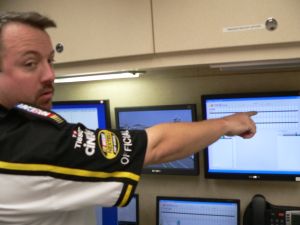How the 'freeze-the-field' rule led to NASCAR's Mobile Technology Center
NASCAR's time machine, Continued
As it stands now, NASCAR doesn't share its timing and scoring feed with any of its teams. Part of the reason for that is because it doesn't want to start granting access to outside parties, for reasons explained in the paragraph above. The other reason is more technological: The data receiving equipment used by most speedways (none of which are bigger than the IMS) and by all the teams and their crews, is a 9600 bps serial connection, sent over a 600 MHz radio frequency. All that's sent over this connection is the current scoring data - and for "freeze-of-field," that means the assessed running order at the time of caution. But it's literally broadcast in little regular pulses through transmitters, and picked up by fairly expensive radio sets - about $2,000 per unit.
James Garr shows where the 'freeze-the-field' results show up.
"The reason it's like that," explained Garr, "is because we have to feed scoreboards, we have to feed stats [statistics], a lot of different people...and they've got software written that's based on serial connections to us. We can't just upgrade and leave them in the dirt."
Over time, it would actually save teams money, Worling said, if the data could be sent faster over network cable. So that's part of NASCAR's next upgrade: For next season, it's considering co-opting with the crews who lay down fiberoptic cable for the digital TV camera connections, so they can about 60 K or so of that bandwidth to send scoring data to teams through everyday network cards. This way, teams would have an interactive client/server connection with the scoring system, which can feed data asynchronously through the loop.
One group that would immediately see the benefit from this upgrade are the TV statistics providers, whose job is to make the commentators they serve seem smarter than they sometimes are. "The next world we're moving into is where we bring the stats group in house," said Worling. "We talk about stats - it's really a group of guys who are providing information to the TV guys in the broadcast booth, and the media center in the press box. Right now, that's all done kinda serially. We're going to switch that." Rather than outsource its statistics service, NASCAR will compile its statistics in-house, and provide that to TV networks along with the scoring data they already receive.
The way the MTC truck is currently staffed, it only needs two scoring officials to monitor data and to interact with officials in the scoring tower - at IMS, in the pagoda. While at first glance, it may look like these guys are actually running software on a bunch of laptops, the truth is, they're interacting with two workstations that are crunching and displaying data being run on the HP servers. If you've ever run applications software on Windows over a long period of time, you already know that uptime seems to throw off its ability to manage real-time - especially if a screen saver should happen to kick in. The way the workstations interact with the TimeGear software, however, the servers are crunching all the data, unimpeded by the activity going on within the workstations' processors. These processors, meanwhile, are managing the SQL Server and proprietary databases, which are not time-intensive processes.
The two banks of wall screens are managed by Nvidia mezzanine cards plugged into the workstations. Each graphics card manages the view for three displays, and could handle more if necessary. Meanwhile, monitoring and other software actually is running on the laptops, unimpeded by the process sequences for the workstation and servers. So even the software procedure has been designed here for maximum efficiency.
Get Tom's Hardware's best news and in-depth reviews, straight to your inbox.
"The workstation environment has really been awesome, that these guys [from HP and AMD] have been able to deliver," said Worling. He was most impressed with the fact that the Quadro Graphics software used on the Nvidia cards utilizes the same screen rendering drivers used by NASA for the Mars Rover mission. There's something else NASCAR has in common now with the space program.
Current page: NASCAR's time machine, Continued
Prev Page NASCAR's time machine, Continued Next Page The big freeze at the Brickyard
